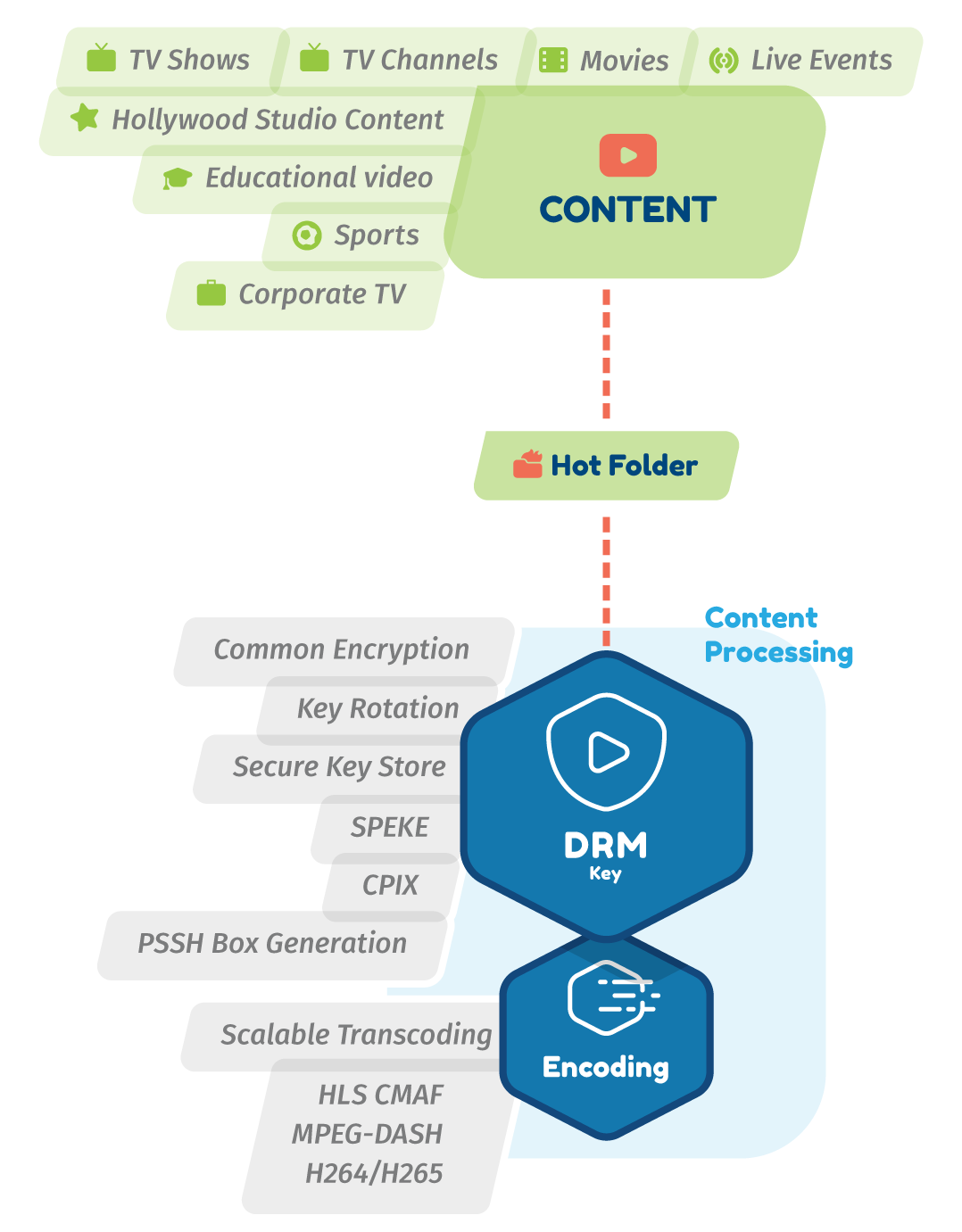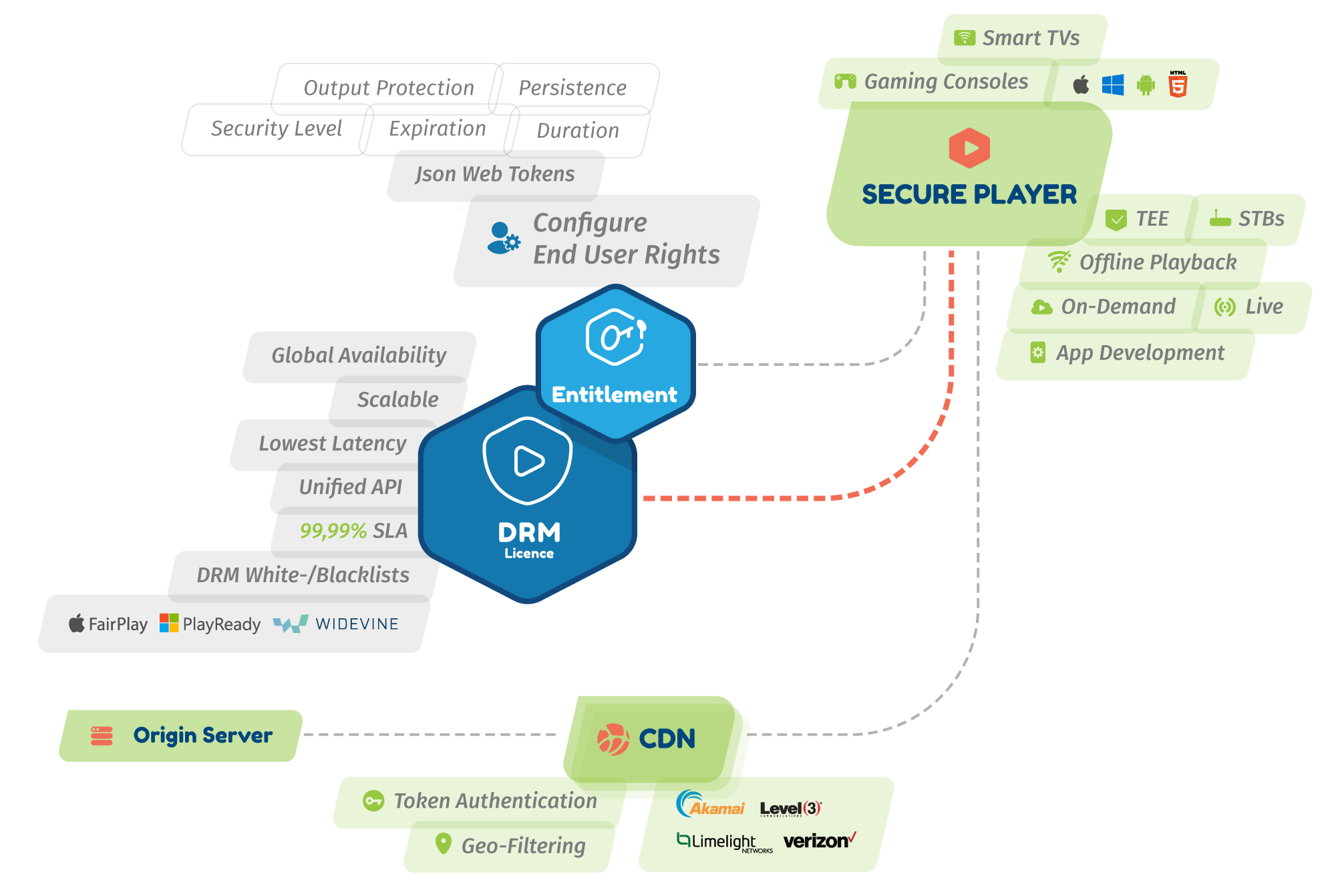

Protecting the Video Supply Chain With DRM
Combatting the Growing Threat of Video Piracy
The digital distribution and widespread popularity of video streaming have significantly increased and globalized the threat of piracy. Piracy of new content is moving away from poor-quality cam recordings from inside a theatre to high-quality versions being leaked online immediately upon release. Digital piracy accounts for annual global revenue losses between $40 and $97.1 billion in the movie industry and between $39.3 and $95.4 billion in the television industry.
The first step towards video protection is identifying at which point in the supply chain is content most vulnerable to piracy.
The Video Supply Chain
You start with a source video that is processed into a format suited for streaming and distribution to a wide internet audience. Once processed, the video is distributed over a CDN or server when a request for playback is made. Now on the other side, you will have an end-user who wishes to play the content from a frontend application on a device. This can be a browser on a PC or even a native TV application. The end-user clicks the play button, activating a content retrieval process, that ends with playback. It is at this very moment where video content is most vulnerable if it’s not protected. An end-user with malicious intent can illicitly record, store and redistribute your videos on the internet with ease. As a result, you will not be able to monetize your content as intended due to the freely available pirated versions.
So how can this loophole be protected to keep piracy at bay?
Introducing DRM
A DRM is a content protection solution that secures videos from piracy by controlling how content is consumed. The DRM service fends off unauthorized redistribution of premium content by limiting access and playback of content to specific devices, locations, and time window.
There are three main flavors of DRM technologies available today, Microsoft PlayReady, Google Widevine, and Apple FairPlay. Implementing all three of them will allow you to reach any device out there. Luckily you don’t have to implement these technologies yourself with Axinom DRM. The multi-DRM service provides a single easy-to-use unified API, regardless of DRM technology, platform, or video player used. It takes care of generating content-encryption keys, administering entitlement, and issuing playback licenses.
Let’s take a look at the video supply chain once more with Axinom DRM implemented.
Implementing Axinom DRM Into the Video Supply Chain
The DRM workflow begins at the preparation phase, where content is encrypted and packaged for delivery. This is handled by the Axinom Encoding service which processes content into commonly used high-quality formats, such as H264 or H265. It then encrypts and packages content for adaptive streaming based on MPEG DASH, HLS, and CMAF formats. The encoding service obtains the encryption keys needed for encryption from the Axinom DRM Key service. Once encrypted, your content is much better suited against piracy and man-in-the-middle attacks.

Now on the playback side of the equation, the media player will need to decrypt the video for viewers requesting playback. For this, the media player will first verify the entitlements you’ve given to the end-user. Once verified, the player receives a token, which it uses to send out a license request to the Axinom DRM License service. The DRM service will validate the request and viewer entitlements stipulated before sending out a license containing the decryption keys. The player can then decrypt the video and start playback for the end-user. All of this happens instantaneously.

The Benefits of Axinom DRM
Easy implementation and widest reach
With the vast number of devices in the market, a DRM must support a multitude of different systems and standards. With Axinom DRM you can get going faster with a single easy-to-use Unified API for protecting live and VOD content across the widest range of devices. Smartphones (iOS and Android), smart TVs, set-top boxes, game consoles, and more are natively supported. Axinom DRM supports the latest media standards, including CMAF, MPEG-DASH, Common Encryption (CENC), and Encrypted Media Extensions.
Offers the highest level of security
Axinom DRM is Hollywood studio-approved with hardware-level DRM support, a prerequisite for licensing 4K, and higher quality content. In order to set different levels of protection based on content quality, our solutions can encrypt content with multiple keys. Together with adaptive streaming, a multi-key approach can optimize hardware use and network congestion and takes into account different security levels of platforms/devices. In order to add an additional layer of security in linear and live-streaming scenarios, Axinom DRM supports key rotation.
Maximum availability and effortless scalability
Axinom DRM is a sophisticated cloud-based solution that runs on globally distributed servers enabling low-latency license delivery to any part of the globe. It is designed to meet the high volume traffic needs of live-streaming and has been performance tested to serve 100,000 DRM licenses per second. The DRM can auto-scale to serve unprecedented spikes in traffic which is common during live events, ensuring zero downtime. Our customers enjoy 99.99% SLA with 24/7 globally guaranteed support.
Future-proof and pay as you grow
Content protection requires ongoing effort and investment to stay ahead of evolving piracy threats. Axinom DRM is a multi-tenant cloud service with a pay as you grow approach. We take on the responsibility of continuously updating the service with the latest technologies and security features. The DRM service offers two pricing models, pay per monthly active users or per DRM licenses generated.
Seamless end-to-end workflows
Axinom DRM is one of many services with the Mosaic platform. Together, Mosaic services power a range of solutions such as video platforms, content management, monetization, and content protection. Axinom DRM supports you in implementing a wealth of business models, including SVOD, AVOD, TVOD, PPV, and hybrid approaches. Moreover, Axinom DRM is SPEKE 2.0 compliant enabling it to easily integrate with 3rd party encoders/packagers that support the specification.








